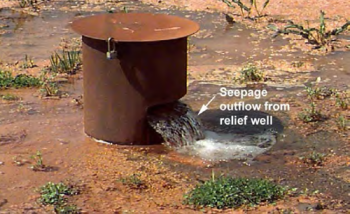Relief Wells: Difference between revisions
Rmanwaring (talk | contribs) (Created page with "<!-- Delete any sections that are not necessary to your topic. Add pictures/sections as needed --> __NOTOC__ ---- {{Picture <!-- Add image file name (ex.image.jpg) --> |image= <!--Add link if applicable --> |link= <!-- Add picture caption --> |caption= }} <!-- Introductory paragraph or topic page summary --> "Relief wells also function as observation wells, but their primary purpose is to reduce the hydraulic head at selected locations along the seepage flow...") |
Rmanwaring (talk | contribs) No edit summary |
||
| Line 4: | Line 4: | ||
{{Picture | {{Picture | ||
<!-- Add image file name (ex.image.jpg) --> | <!-- Add image file name (ex.image.jpg) --> | ||
|image= | |image= ReliefWell.png | ||
<!--Add link if applicable --> | <!--Add link if applicable --> | ||
|link= | |link= | ||
<!-- Add picture caption --> | <!-- Add picture caption --> | ||
|caption= | |caption= "Figure 7-9. Relief well seepage outflow. Although relief wells are not typically installed for the primary purpose of seepage water monitoring, their outflow can be collected, measured, and evaluated similar to open piezometers or observation wells."<ref name="FEMAP1032" /> | ||
}} | }} | ||
Revision as of 23:52, 2 November 2022

|
| "Figure 7-9. Relief well seepage outflow. Although relief wells are not typically installed for the primary purpose of seepage water monitoring, their outflow can be collected, measured, and evaluated similar to open piezometers or observation wells."[1] |
"Relief wells also function as observation wells, but their primary purpose is to reduce the hydraulic head at selected locations along the seepage flow path... Relief wells for dams have specific problems associated with the plugging of the filter packs or the accumulation of bacteria or carbonates (USACE 1995). It is often necessary to install piezometers adjacent to relief wells to measure and monitor the pressure increases associated with clogged wells. Relief wells typically require regular maintenance for long-term proper functioning, including re-development, chemical treatments, and disinfection."[1]
Best Practices Resources
![]() Evaluation and Monitoring of Seepage and Internal Erosion (FEMA P-1032) (FEMA, 2015)
Evaluation and Monitoring of Seepage and Internal Erosion (FEMA P-1032) (FEMA, 2015)
![]() Instrumentation of Embankment Dams and Levees (EM 1110-2-1908) (USACE, 2020)
Instrumentation of Embankment Dams and Levees (EM 1110-2-1908) (USACE, 2020)
![]() ACER TM 9 Guidelines for Controlling Seepage Along Conduits Through Embankments (USBR, 1987)
ACER TM 9 Guidelines for Controlling Seepage Along Conduits Through Embankments (USBR, 1987)
![]() Engineering and Design: Construction and Maintenance of Relief Wells (EM 1110-2-1914) (USACE, 1986)
Engineering and Design: Construction and Maintenance of Relief Wells (EM 1110-2-1914) (USACE, 1986)
Trainings
Citations:
Revision ID: 4095
Revision Date: 11/02/2022
